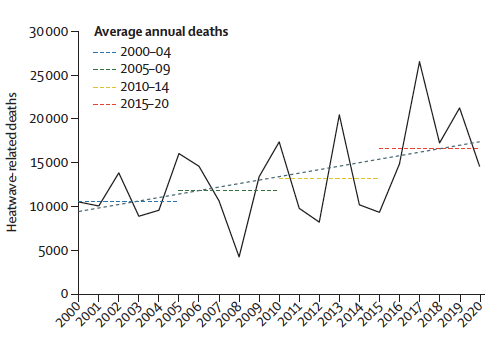

Every medical worker has the sense of mission and responsibility to help the public that comes as a part of the profession. In order to better serve the health and justice of its communities, they stick to the original intention of their profession, which is to treat diseases and save lives. In recent years, as the health impact of climate change become more severe, health workers on the front lines carry more responsibilities and need to become advocates for climate action as their oath states "first do no harm".
Climate disaster caused by climate change
The phrase "the climate crisis is first and foremost a health crisis" was repeated at the COP26 held in Glasgow last November and in the report published by Health Care Without Harm (HCWH). According to the World Health Organization (WHO), climate change will be the biggest global public health challenge in the 21st century, and the most impacted region will be Southern Asia[1]. However, very few countries are fully prepared for this major challenge. As one of the largest country in economy and population, the impacts of climate change on China's community health will become more obvious. Among those, the largest impacts will come from natural disasters, warming temperatures and infectious diseases. According to the 2021 Lancet report on China[2], the average number of warm temperature days in China in 2020 was 4.51 days higher than the 1986-2005 average. The resulting heatwave-related mortality rate increased by 92% compared to the 1986-2005 average. About 14,500 people died from heatwaves in 2020.
Figure 1: Average annual increase in mortality from heat

As well, the frequency of natural disasters such as floods and forest fires is also increasing every year. In 2018, 35.26 million people were affected by floods and 27.43 million by drought. The major flooding in Zhengzhou, Henan, in July 2021 killed more than 300 people. The frequency of forest fires has increased by 25% in the past 20 years, and the associated widespread air pollution has a long-term impact on the health of its surrounding population. The increase in infectious diseases brought about by rising temperatures is another major challenge to public health in China. Between 2004 and 2019, the capacity of dengue transmission vectors in 18 provinces in China increased by 25.4% due to rising daily temperatures, meanwhile, the outbreak of COVID-19 that began at the end of 2019 has brought reminder to all of the importance of health and safety.
Seize the opportunity
The impact of COVID-19 has been devastating. As of 1 March 2022, the outbreak has killed some 5.95 million people[3]. For a time, the seemingly powerful medical systems around the world were tested, and struggled to combat the virus. Although the pandemic has been going on for two years, many health systems are still struggling. While the COVID-19 pandemic is a serious and urgent health crisis, the health impact of climate change will be even more severe in the coming years and even decades.
In China, medical workers, as the first line of defense for the outbreak of health crises, are not only the main force in saving people and treating diseases, but also the promoters of preventing diseases and health disasters. The healthcare sector is also highly aware of the new and recurrent infectious diseases caused by climate change, and in a questionnaire survey of domestic health care workers[4], it was shown that most health workers believe that climate change will cause significant harm to human health. Among them, high temperature weather and infectious diseases are the most harmful to the elderly over 65 years old, children under 5 years old and people with poor health conditions in remote areas.
In a study published in 2020, 89% of healthcare workers surveyed acknowledged that climate change has had a significant impact on the increase in dengue fever[5]. Although 90% of the medical workers interviewed in the 2016 questionnaire were very confident in their professional knowledge and the hospital's infectious disease prevention system, in the early stage of the COVID-19 outbreak, more than 30,000 medical staff across the country still needed to be dispatched to support the fight against the pandemic in Wuhan[6] to supplement the lack of local infectious disease prevention efforts.
The COVID-19 pandemic and climate change have a lot in common, from its root causes to its response mechanisms. In order to be able to prevent more serious health crises decades later, it is crucial to help health workers become advocates for climate action from the following three points. First, both national and local policy mechanisms should include health impact evaluations. China's new National Bureau for Disease Control and Prevention, which was established in April 2021 by health policymakers', still has no climate and health-focused sections. Nor are its policies directly addressing regulations on the health impacts associated with climate change. In the context of achieving China's 3060 double carbon goal, integrating health impacts into strategic policies will help frontline health workers gain access to more resources and information to enhance the resilience of local health systems and accelerate the path of carbon reduction, in order to reduce the health impacts of climate change[7].
Second, more effective cross-sectoral cooperation across local government sectors is important to strengthen its health defenses. Emergency response systems, meteorological departments and health departments should secure public health through better communication and collaboration. Currently, only 10 of China's 31 provincial meteorological departments support public health-related decisions. Provincial government emergency response policies to ensure public safety need to be more refined and sound.
Finally, the support of hospitals and regional health commissions is indispensable. As the first line of defense of health, hospitals and its workers have the authority and professionalism to ensure the health and safety of the general public. In a questionnaire published in a study, health workers said they are willing to strengthen the capacity of individuals and institutions to cope with the impact of climate change on public health. They are willing to gain knowledge, advocate for patients, participate in building community resilience, and strengthen care for people at high risk and in remote areas[8]. Conscious education for healthcare workers can help high-risk populations prevent the damaging health effects of climate change in advance. In decarbonization pathway for healthcare institutions published in 2021 by HCWH, it also points out the importance of frontline healthcare workers in reducing emissions in its system. Though challenging to accomplish, their daily communication and interaction with patients can effectively communicate relevant knowledge on climate change, and their daily decision on the use of medical instruments and medicines can affect the hospital's supply chain and associated energy consumption[9]. Outside of the usual high-intensity work, the lack of funding, resources and training support prevents medical workers from effectively seizing existing opportunities in supporting public health challenges from climate change.
Conclusion
The effective participation of health workers is critical to mitigating the major threats to public health from climate change. They are fully capable, willing, and resourced to change the status quo, but they do not have enough support to be fully prepared. Shortages of funding and labor also pose a huge obstacle. While learning from the lessons of the most recent pandemic responses, the government has an obligation to protect the continued health and stability of the public as soon as possible by integrating the climate change and public health agenda into public decision-making, increasing cooperation among local government departments, increasing sustainable financial investment and capacity building for healthcare workers, including covering specific content related to climate change in medical education courses.
Note:
[1] WHO. Quantitative risk assessment of the effects of climate change on selected causes of death, 2030s and 2050s. 2022. https://apps.who.int/iris/handle/10665/134014
[2] Cai W, et al. The 2021 China report of the Lancet Countdown on health and climate change: seizing the window of opportunity, Lancet Public Health 2021; 6: e932–47, November 7, 2021 https://doi.org/10.1016/ S2468-2667(21)00209-7
[3] John Hopkins University. COVID-19 map of Johns Hopkins coronavirus resource center. 2021. https://coronavirus.jhu.edu/ map.html (accessed Feb 28, 2022).
[4] Tong M, et al. China’s capacity of hospitals to deal with infectious diseases in the context of climate change. Social Science & Medicine (206) 2018, 60-66.
[5] Yang L, et al, Local actions to health risks of heatwaves and dengue fever under climate change: Strategies and barriers among primary healthcare professionals in southern China. Environmental Research 187 (2020) 109688.
[6] 人民日报聚焦一线医务工作者:战胜疫情的中坚力量. 2020年2月23日。https://baijiahao.baidu.com/s?id=1659283620292430927&wfr=spider&for=pc
[7] Kreslake et al. The Critical Roles of Health Professionals in Climate Change Prevention and Preparedness,AJPH Supplement 2, 2018, Vol 108, No. S2,Link:https://ajph.aphapublications.org/doi/pdfplus/10.2105/AJPH.2017.304044
[8] 同5
[9] Healthcare without Harm, Global Road Map for Health Care Decarbonization. 2021. https://healthcareclimateaction.org/roadmap
Author:Pan Yiren
Translation: Pan Yiren
This article is an original article of the Rock Environment and Energy Institute. Please contact us to obtain the appropriate authorization to reprint. For cooperation and authorization, please send an email to: liying@reei.org.cn
* This is the translation of an article in Chinese. Should there be any inconsistency between Chinese and English version, the Chinese version shall prevail.




